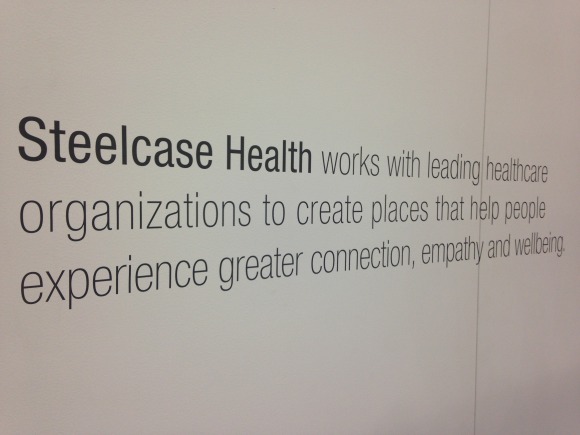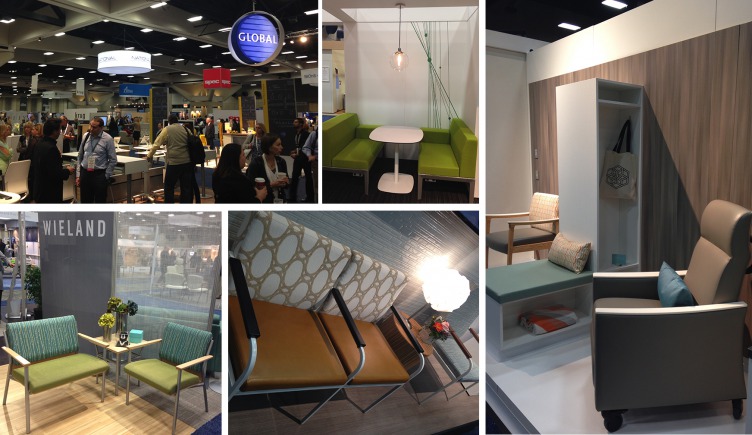 HEALTHCARE DESIGN
HEALTHCARE DESIGN
I focus on healthcare design for many reasons. I work to improve healthcare spaces to make these environments more efficient, safe, and calming. The users of these spaces are ill, injured, worried, and stressed. Design is never neutral. It either helps, or it hurts. It is my job to collaborate with others to better these environments for the patients, their families, and the caregivers. A few weeks ago, I attended the Healthcare Design Conference in San Diego, California. The conference is held annually, and is attended by leading healthcare providers, manufacturers, and designers. The healthcare industry is in a time of change, and a time of uncertainty. Hospitals have shifted from “getting paid to deliver care”, to “getting paid to make people healthy”. The system is shifting from volume to value. Because of all of this change, there is a lot to learn and a lot to be inspired by. The people that attend this conference are extremely passionate and educated about healthcare design. I came back with a notebook full of notes.
The day before the conference started, I met with my Community of Practice Group. This group is comprised of about 40 members. We are all involved in healthcare design and represent Steelcase dealerships across the country. We meet two times a year, and each time the group grows larger. Individuals representing Steelcase Health also attend and participate.
TIME FOR A CHANGE: NEW SOLUTIONS FOR HEALTHCARE PLACES
Steelcase leadership discussed new healthcare research findings and shared a document called Time for a Change: New Solutions for Healthcare Places. It focuses on humanizing the patient’s experience, and empowering them with information. This makes the experience more personal, reduces stress, and allows patients to make educated decisions about their care.
Below, are some highlights from this research.
“Healthcare is evolving at a rapid pace, changing on almost every imaginable front, as patients and payers seek improved experiences, outcomes, and value.”
“The focus is expanding beyond illness to include wellness and wellbeing.”
“Care providers are driving to more patient-centered care, taking time to involve patients in co-managing their health.”
“Improving health outcomes goes beyond diagnosing and treating illness. It also includes preventative care, teaching patients and families and consulting to encourage healthy behaviors and well-informed decisions about care.”
“Increase satisfaction, a measure of provider success that is rising in importance.”
“Enhance vital connections by designing for the human factor.”
It goes further into detail on Exam Spaces, Clinician Workspaces, Patient Rooms, Oncology, and Waiting Areas.

Each time our Community of Practice meets, part of our time is spent in small groups discussing specific topics such as training opportunities, marketing strategies, success stories and lessons learned. It’s always so beneficial to meet with this group. Most members have many, many years of experience and have a lot to share. I learn tremendous amounts each time.

CLASSES
For the next few days of the Conference, I attended six classes. They range on topics, but are all very specific and interesting.
The first class, was all about how the physical environment can influence patient satisfaction. They explained the importance of questioning what patterns of care provide the best outcomes, for which patients, under what conditions. This idea supports the study of Evidence-Based Design.
The second class focused on exploring relationships in architecture, specifically the spatial layout of the patient room and nursing unit. Credible research states that the layout of a patient room influences patient outcomes. For example, room handedness proves to affect medical errors and patient falls, and giving patients views of nature gives them a sense of morality. The environment of care shapes the patient experience. Spaces must be designed to increase the experience of the patient, their family, and the caregivers.
“Every system is perfectly designed to achieve exactly the results it gets” – Dr. Paul Batalden
My third class focused on the impact of art programs at Hospitals. The presenter went through a Case Study on Cincinnati Children’s Hospital. This hospital started an art program that was very patient and family centered. This area of the hospital was for long-term care. Upon checking in, the patients were involved in choosing the artwork that would surround them. They were also given the opportunity to create their own artwork. Their program involves music, meditation, and movement classes to inspire the patients to create. In turn, these methods also offered relaxation to the patients and their families. Artwork is so much more than an accessory to the space, especially in healthcare.
- Compliments interior design palette
- Creates a sense of daylight
- Deploys nature based images
- Brings cheer, reduces stress and anxiety
- Decreases the perception of pain
- Provides a positive distraction
- Adds cultural enrichment through the arts
- For long term patients, artwork can give a sense of familiarity and comfort
Another class was called Creating Positive Birthing Experiences. The focus in healthcare facility design is changing from functional delivery of care, towards a greater emphasis on psychologically supportive healing environments. Birthing satisfaction is critical to long term hospital revenue, and impacts women and pediatric patient volumes.
The last two classes revolved around caring for caregivers. If caregivers are unhappy or unwell, how can they possibly deliver the best care to their patients? So, in order to take the best care of patients, you must start at the top. It is in hospital stakeholder’s best interest to keep their employees feeling positive and optimistic about their jobs. The top three factors that impact staff satisfaction have proven to be natural light, color/texture/finish, and ease of communication between colleagues.
The last aspect to this conference is the Exhibit Hall. The Exhibit Hall features hundreds of providers showing innovative products, and live demonstrations that support the design on hospital and clinic environments.

Health is not just the absence of disease. It is also having spiritual, mental, and emotional well being. The Healthcare Design Conference touches on every aspect of healthcare design. I so appreciate the opportunity to attend such a crucial event in this industry. It feels really good to visit a healthcare setting and see patients and their families finding comfort in a space that you helped create. I look forward to gaining more experience and impacting healthcare spaces for the better.
by Michelle Smith, Healthcare Design Consultant


